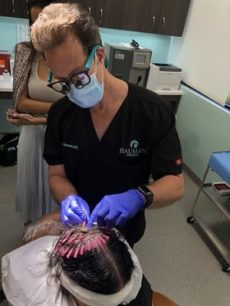Polydioxanone (PDO) threads have become a popular treatment option for facial rejuvenation, facelifts and wrinkle reduction in recent years. This is especially true in Asian countries such as South Korea, where PDO threading is a common cosmetic procedure.
Polydioxanone filament is a synthetic absorbable suture that is prepared from polyester. PDO sutures have been used safely in surgical practices for decades. While PDO is the most commonly used material, some scientists have also successfully tested gold threads for hair growth. These gold threads were embedded with absorbable polyglycolic acid (PGA).
More recently, doctors have been using thread-embedding therapy (TET) for hair growth purposes. Some sources use other words to describe this technology, including “thread lifting”, “threading” and “polydioxanone monofilament threads”. Well known brand names include PDOgro (discussed further below) and EuroThreads. You can find numerous online reviews for these procedures when it comes to facial applications.
Polydioxanone Monofilament Threads and Hair
A detailed 2015 study from South Korea showed positive hair growth results in mice treated with TET. The logic behind this type of procedure is similar to the logic behind wounding and hair growth. As well as to the related microneedling and dermarolling phenomena.
The hair threads and associated wounding work by: stimulating collagen regeneration; increasing blood flow; and improving circulation. Moreover, various growth factors are increased after the scalp skin has been disrupted. The threading treatment also enhances hair growth related gene expression, and activates fibroblasts and elastin.
Polydioxanone threads seem to be the most popular option for this type of procedure. In June 2017, a new study from India (with Dr. Rachita Dhurat as a co-author) caused significant excitement about this procedure. The study authors inserted 30 millimeter PDO microfilament threads in five male patients suffering from androgenetic alopecia (AGA). Between 20 to 40 threads were inserted into each scalp.
At 12 weeks, all five patients had appreciable increases in hair count. Of significance, none of these patients had previously seen any hair growth from using either Finasteride or Minoxidil. According to the above paper, poly-dioxanone has high flexibility and retention strength. It is also non-allergenic and has a slow absorption rate of around 6–8 months.
And most recently, in December 2019, a new study from Egypt concluded that:
“Poly‐l‐lactic acid microthread therapy combined with minoxidil may improve hair density, hair thickness, and hair appearance better than minoxidil alone.”
PDOgro™ Hair Growth and Dr. Alan Bauman

Over the course of 2019, Dr. Alan Bauman from Florida has become heavily involved in the PDOgro™ procedure for hair regrowth. I first read about this in a February 2019 press release.
The PDOgro™ process is performed under local anesthesia via the insertion of PDO MasterThreads (MasterThreadsUSA, NY).
Over the past few months, Dr. Bauman has sent me a bunch of information and videos about this procedure. He thinks that it has significant hair growth benefits. Below is a video in which he is demoing the PDOgro procedure on a live patient at a conference in early 2019. Dr. Bauman was already performing this hair loss treatment in 2018 per this slightly older video.
Scalp Threading Plus Minoxidil and PRP
Doctors who offer PDO thread treatments on the scalp often add concurrent topical hair loss medications into the mix. Some might also offer to add PRP as a combination treatment. Medication absorption rates are probably increased after the wounding process.
It would be quite ironic if “PDO threads plus added compounds” turns out to be as effective as Follica’s “wounding plus added compounds” hair loss treatment.